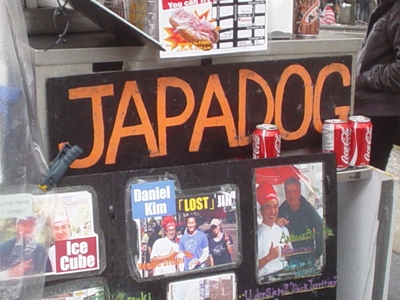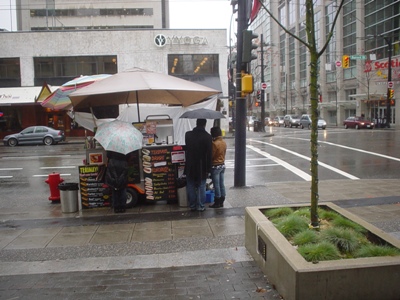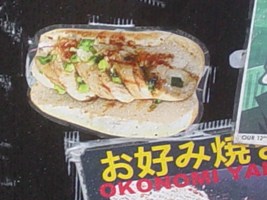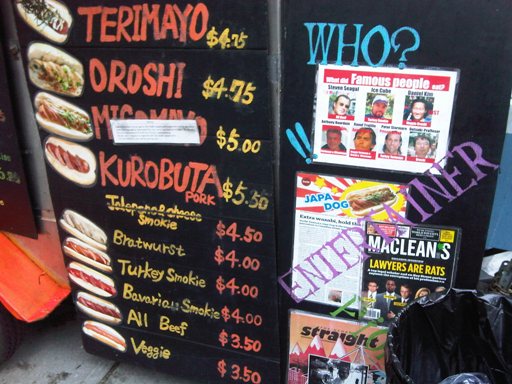Japadog
Appearance
Japadogs are Japanese style Hot dogs native to Vancouver, Canada.
Japadog sign at Burrard and Smithe, Vancouver.
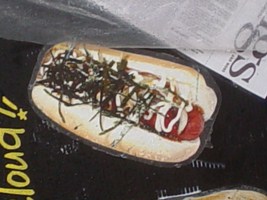
History of the Japadog
- Noriki Tamura opened the first Japadog stand in 2005. Tamura worked in advertising in Tokyo but decided to apply for a street vending licence and moved to Canada with his wife in 2005.[6] He originally wanted to sell crêpes but due to strict regulations set forth by the City of Vancouver, he had to settle with Hot dogs and soda. After apprenticing for 3 months at a Hot dog stand, he decided to open his own with a little twist. In order to compete with more than 100 Hot dog stands in Vancouver, Tamura created something unique and has rapidly become very popular. [12] He owns three Hot dogs stands and is opening a restaurant on Robson St. this December 2009. This innovative fusion of Japanese ingredients and the traditional North American Hot dog has been featured in many local newspapers and news channels such as the Vancouver Sun and CTV.[5]
Japadog stand at the corner of Burrard and Smithe, Vancouver.
Japadog Menu
- Classic:
- Terimayo: Teriyaki sauce, Japanese mayonnaise, sautéed onions, sprinkled with nori (dried seaweed flakes). Choice of kurobuta(pork from Berkshire pig (black pig)), bratwurst (pork), turkey, beef or veggie sausage
- Misomayo: turkey sausage, miso sesame sauce, fried onions, radish sprouts, Japanese mayonnaise
- Okonomi: kurobuta pork sausage, special okonomi sauce, Japanese mayo, fried cabbage, bonito flakes (dried fish flakes)
- New[5]:
- Spicy Cheese Terimayo: jalapeno and cheese smoky, teriyaki sauce, cheese, Japanese mayo, nori
- Kurogoma Kimchi: turkey sausage, special kimchi (cabbage with spicy sauce), kurogoma (black sesame seed)
- Ume: bratwurst, special plum sauce, raw red onions
- Edamame: bratwurst and edamame (soybeans)
- Fishdog (sausage from different kinds of fish: mackerel, Pollack, atka, hoki)
- Korokke: beef sausage, mashed potato, cabbage, yoshoku sauce, mayo
- Okura : bratwurst sausage, sautéed okra
- Regular Hot dogs (also sold at Japadog stand):
- Jalapeno and cheese, turkey, bratwurst, beef or veggie sausages. Then choose from these common Hot dog ingredients: ketchup, mayonnaise, mustard, relish, banana peppers, sauerkraut etc.
Sign at Japadog stand.
Locations
- Burrard St. and Smithe Hours: Mon - Thu: 12pm to 8pm, Fri - Sat: 12pm to 9pm, Sun: 12pm to 8pm[5]
- Burrard St. and Pender Mon - Fri: 11am to 2pm
- 480 Broughton St. Vancouver at Coal Harbor Community Centre[12]
History of Street Vending
- Street food and vending in general is a practice which can be traced back several centuries. The earliest form of this now popular profession occurred among those traveling by foot, moving from trading post to trading post who would look to the communities they were passing through to supply them with food. In New York, where street food is the norm, evidence of the trade can be traced back as early as the 15th century when pushcarts and peddlers appeared on the streets.[7] Like in Vancouver, new immigrants to New York (predominantly Jewish and Italian at the time) viewed street vending as an opportunity to make money without necessarily having to learn the language or a new skill. Now, in Vancouver as well as New York immigrants from all over the world are street vending as a means of employment.
- There are several advantages to street vending as opposed to retail shops, including the ability to pack up an entire business and disappear overnight, minimal overhead and the option to move freely about the city. However, there are downsides. Advertising is often limited to signs in front of the stall and there are many city regulations for street vendors.[17] In Vancouver, street vending is encouraged to bring together the community, as mentioned on the City of Vancouver website.[3] Anything from heated food and drink items to flowers to handmade products such as art or clothing is permitted to be sold on the streets of Vancouver. Most famous are 99cent pizza slices, hot dogs and hybrid flavours such as those sold at the Japadog stands.[20]
History of Hot Dogs
- “The noblest of all dogs is the hot-dog; it feeds the hand that bites it.”
- - Dr. Laurence J Peter
- Many lay claim to inventing the hot dog and, indeed, each may be right as the idea of eating cooked sausage inside a bun appeared in several different locations concurrently. Sausage, which consists of smoked, spiced meat stuffed into a thin casing and typically served warmed, has been a popular staple in several countries at least as far back as the 9th century BC as it is referenced in Homer’s Odyssey which was written around 850 B.C.[11]
- Hot Dogs are also know as frankfurters or wieners and while it has been argued that the name frankfurters is proof that the inventor was German- born butcher Johann Georghehner who in the late 1600’s famously arrived in Frankfurt to promote his newest product, "dachshund sausage". Conversely, the name wiener is an abbreviation of wienerwurst which supports Austria’s claim that an Austrian butcher invented the hot dog as “Wien” in German means Austria, while “wurst” means sausage.[11]
- Regardless of its origin, hot dogs did not gain much of a following outside Germany and Austria until introduced to the Americas by German immigrants. In 1867, Charles Feltman made his living by baking pies and selling them along the beaches of Coney Island. His clients asked Charles if he could also provide them with hot sandwiches. Lacking space, Charles decided the best he could do was cook sausages and served them in rolls and, thus, became the first Coney Island hot dog stand.[10]
- Another story describes a peddler in St Louis, Antonoine Feuchtwanger, who, frustrated when his patrons walked away with the gloves he provided so they wouldn’t burn their hands on the hot sausages, asked his brother-in-law, who happened to be a baker, to create a long, soft, split bun to put the meat into.[11]
- Whether it was Germany or Austria, Charles or Antonoine, the hot dog grew in popularity as people increasingly sought food that was affordable and easy to eat. Events like the 1893 Chicago World Fair, the 1904 St Louis World Fair, and the growing popularity of baseball games introduced thousands of people to hot dogs as vendors set up booths outside stadiums and fairgrounds.
- Still primarily called dachshund sausage, the name hot dog was most likely a descriptive derivative as vendors sought to attract customers to their carts – after all, “get your hot dachshund sausage roll” is quite a mouthful! There was, however, a lingering urban legend that the name hot dog alluded to the meat used rather than the traditional German name of the sausage.
- By the early 20th century, hot dogs were associated so strongly with America and the American lifestyle that President Franklin Roosevelt “wanting to introduce something truly American” served King George XI hot dogs for lunch during his royal visit on June 11, 1939.[9]
- Given the history of the hot dog, this event aptly illustrates the influence and impact of cross-cultural exchanges as Roosevelt served an “American favourite” to a British King of German descent!
History of Sushi
- Sushi’s origin can be traced back to somewhere in Southeast Asia around the 4th Century BC. This first appearance of sushi is now referred to as nare-sushi[14], and unlike the common sushi of today, it was a preserved food that underwent several months of fermentation and the fish (preserved rather than raw) was not eaten with rice.
- A common misconception about the history of sushi is that it originated in Japan. However, sushi wasn’t introduced into Japan until sometime in the 8th Century AD, after it had circulated throughout China. This earliest Japanese rendition of sushi was known as seisei-zushi[13], and unlike the nare-sushi, it was consumed with the fish still partly raw and also with rice. In the Edo era of Japan’s history, the Japanese created haya-zushi[18] as a sushi type that combined the raw fish and rice with vinegar and other vegetables. From here until the 19th Century, different regions of Japan began making different kinds of sushi that have been passed throughout generations. The most popular form of sushi that came from the earlier generations of Japanese sushi, nigiri-zushi, (also referred to as edomae-zushi) refers to the two most common ingredients of sushi world-wide: rice, seasoned with vinegar, topped with one piece of raw fish (or sashimi).[15]
- Renee Dietz[1] provides 3 lists of sushi essentials including Preparation, Common Types and Ingredients:
Preparation
- Bara Sushi – The vinegar rice and ingredients are mixed as a salad
- Chirashi Sushi – The rice bed has various layers of fish and is served in a bowl called Gomoku Sushi or Iso-don
- Futomaki – This is a large Maki roll that has many different ingredients using Nori, which is a seaweed wrap
- Inari Sushi – Instead of using the traditional vinegar rice, brown, fried tofu is used
- Nigiri Sushi – Vinegar rice topped with a slice of raw or cooked fish, or vegetables
- Okonomi Sushi – This is home-style Nigiri
- Onigiri – This Sushi is made with regular steamed rice and rolled into a ball with other ingredients
- Oshizushi – Vinegar rice and other ingredients of choice pressed into a mould
- Temaki – These are cone-shaped seaweed rolls also called a hand roll
Common Types
- Amaebi – Sweet shrimp

Different types of sushi. - Boston Rolls – Crab, salmon, and scallion
- California – Crab and avocado
- Ebi – Shrimp
- Egg Salad Rolls – Hard-boiled eggs, mayonnaise, and green onion strips
- Hamachi – Yellow Tail
- Hirame - Halibut
- Holiday Rolls – Turkey, cranberry salsa, and cream cheese strips
- Hotate – Scallop
- Ika – Squid
- Ikura – Salmon roe
- Kani - Crab
- Kappa Ma – Cucumber
- Maguro – Tuna
- Masago – Smelt Roe
- Mirugai – Giant clam
- New York Rolls – Smoked salmon, apple, and avocado
- Pesto Rolls – Turkey or chicken, cream cheese strips, and pesto
- Philadelphia Rolls – Smoked salmon, cucumber, and cream cheese strips
- Saba – Mackerel
- Sake - Salmon
- Shrimp Rolls – Shrimp and cream cheese strips
- Smoked Salmon Rolls – Smoked salmon, cucumber, and cream cheese strips
- Spider Roll
- Summer Melon Rolls – Prosciutto and melon strips
- Tako - Octopus
- Tai – Red snapper
- Tamago – Egg
- Tekka Maki – Tuna Roll
- Temaki – Spicy tuna
- Texas Rolls – Cooked beef, cucumber, and spinach leaves
- Toro – Fatty Tuna
- Tuna Salad Rolls – Tuna salad and lettuce leaves
- Unagi – Eel
- Uni – Sea urchin
- Veggie Rolls – Pesto, cucumber, tomato, mushrooms, scrambled egg, scallions
Common Ingredients (Possibly used for Japadogs)
- Short-grain white rice
- Nori (seaweed)
- Mirin (sweet rice wine)
- Seasoned rice vinegar
- Prawns
- Barbecue or regular eel
- Caviar
- Albacore
- Avocado
- Alpha or bean sprouts
- Asparagus
- Shitake mushrooms
- Cream cheese
- Tempura batter
- It is very common for each sushi bar to create their own variations in each of the sushi types. Geographically speaking, sushi restaurants usually have a specific type, or several types that are named for the city that they are in. For example, the Seattle Roll, the B.C. Roll, Flames Roll Combo (Calgary) etc.[4] Today, sushi is served with wasabi[21] (also known as Japanese horseradish), pickled ginger, and a variety of soy sauces[19]. Also, as a Japanese tradition, sushi is commonly served with green-tea to cleanse the palette.
Japanese Cuisine Goes Mainstream
- Sushi was clearly becoming a staple food in Japan by the 1950’s. Due to the contemporary refrigeration system, products could be easily stored and the onset of more ingredients made for far greater menu options. Moreover, the concept of “conveyor-belt sushi restaurants” began to appear due to business owner Yoshiaki Shiraishi’s aim to reduce labor costs.[8] This idea would play a large part in the success of sushi in the Western world.
- The appearance of sushi in countries other than Japan was largely due to expatriate Japanese communities found in countries such as Brazil, Australia, North America and so on.[8] With such large communities in the Pacific coast of North America, many Japanese chefs flocked to the areas in order to promote Japanese cuisine. Canada in particular experienced Japanese immigration, especially in southwestern British Columbia between 1900-1940[16], creating a market for Japanese cuisine.
- Amongst the Japanese chef’s to immigrate to Canada was Hidekazu Tojo, who moved from Japan to Vancouver in the 1970’s; a city whose Japanese population was growing, but where there were only four Japanese restaurants.[2] With his experience working in Osaka, Tojo moved to Vancouver with the expectations of expanding the West Coast culinary scene using the foods he had learned to master, including sushi. While there is debate over whether or not he created the California Roll or another very famous Japanese chef did (Ichiro Manashita in Los Angeles) Vancouverites were introduced to exotic ingredients, a new style of cooking and a new cuisine altogether.[8] Tojo’s popularity boomed in 1988 when he opened his now world famous restaurant, “Tojo’s” with menu items such as the California Roll, B.C. Roll and many other culinary specialties.[2] His take on sushi has created a lasting legacy in Japanese restaurants all around the Northwest, introducing ingredients that are now staples at most Sushi Bars. His presence in Vancouver has truly cultivated a great respect and demand for all things Japanese food related. Tojo’s incredible impact on the sushi world no doubt makes Vancouverites even more receptive to Japanese cuisine in any form.
References
- 1. Asian Art Mall http://www.asianartmall.com/typesofsushi.html, accessed Nov. 22, 2009
- 2. BC Restaurant Hall of Fame, “Industry Award- Back of House”, http://test.bcrhof.com/ bio_HidekazuTojo_2006.php (accessed Nov. 22nd, 2009)
- 3. City of Vancouver http://vancouver.ca/engsvcs/streets/retailUse/vending.htm, accessed Nov. 23, 2009
- 4. Globefish Sushi & Izakaya http://globefish.ca/, accessed Nov. 22, 2009
- 5. “Japa Dog,” Japan Consulting Corporation. http://www.japadog.com/ (accessed November 20, 2009)
- 6. Nancy, MacDonald. “Extra wasabi, hold the seaweed.” Maclean’s 30, vol. 120 (August 2007):58.
- 7. NYC Street Vendors http://macaulay.cuny.edu/student-projects/2007/neighborhoods/11/fernandes_site/PeopleofNY/Site/Street_Vendors-_Main_Page.html, (Nov. 5, 2004), accessed Nov. 23, 2009
- 8. Renton, Alex, “How Sushi Ate the World,” Observer Food Monthly, February 26th, 2006 http://www.guardian.co.uk/world/2006/feb/26/japan.foodanddrink (accessed Nov. 22nd, 2009)
- 9. “Royal Visit, June 1939” http://docs.fdrlibrary.marist.edu/royalv.html (accessed on November 21, 2009)
- 10. Stanton, Jeffery. “Coney Island: Food and Dining” http://www.westland.net/ (accessed on November 21, 2009)
- 11. Strandley, Linda. “History and Legends of Hot Dogs” http://www.whatscookingamerica.net/ (accessed on November 21, 2009)
- 12. “Street meat, Japanese-style,” http://www.theglobeandmail.com/life/food-and-wine/street-meat-japanese-style/article1154735/ (May 27, 2009), accessed Nov. 23, 2009
- 13. Sushi Bar http://www.thesushibar.ca/all_about_sushi/, accessed Nov. 22, 2009
- 14. Sushi Encyclopedia http://www.sushiencyclopedia.com/blog/2007/10/05/primative-sushi/, accessed Nov. 22, 2009
- 15. Sushi-Master http://www.sushi-master.com/usa/whatis/history.html, accessed Nov. 22, 2009
- 16. The Canadian Encyclopedia/The Encyclopedia of Music in Canada, “Japanese Canadians”, http://www.thecanadianencyclopedia.com/index.cfm?PgNm=TCE&Param=A1ARTA0004108 (accessed Nov. 22nd, 2009)
- 17. Transient Business: A Street Vendor Typology and Exploratory Study http://findarticles.com/p/articles/mi_qa5424/is_200703/ai_n21286345/, accessed Nov 22, 2009
- 18. Wapedia http://wapedia.mobi/en/History_of_sushi , accessed Nov. 22, 2009
- 19. Wikipedia http://en.wikipedia.org/wiki/Soy_sauce, accessed Nov. 22, 2009
- 20. Wikipedia http://en.wikipedia.org/wiki/Street_food , accessed Nov. 22, 2009
- 21. Wikipedia http://en.wikipedia.org/wiki/Wasabi, accessed Nov. 22, 2009
